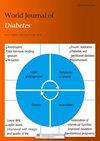Early hemodynamics after tibial transverse transport in patients with nonarterial stenosis and arterial stenosis diabetic foot
IF 4.2
3区 医学
Q1 ENDOCRINOLOGY & METABOLISM
引用次数: 0
Abstract
BACKGROUND The diagnosis of peripheral arteriopathy in the diabetic foot is complicated by diabetes and its advanced complications. It has been found that diabetic foot can be categorized into arterial stenosis and non-arterial stenosis, both of which have significant differences in hemodynamic characteristics. AIM To evaluate the early hemodynamic changes in diabetic foot patients with nonarterial stenosis and arterial stenosis treated by tibial transverse transport (TTT) using high-frequency color Doppler ultrasonography (HFCDU) and a laser Doppler flowmeter. METHODS Twenty-five patients with Wagner grades 3-5 diabetic foot ulcers were treated with TTT, and the wound healing time and rate were recorded. Patients were grouped according to the results of preoperative lower-extremity ultrasonography. Cases with ≥ 50% stenosis in any of the femoral, popliteal, posterior tibial, anterior tibial, and peroneal arteries of the affected limb were classified as the arterial stenosis group (n = 16); otherwise, they were classified as the nonarterial stenosis group (n = 9). Before and one month after surgery, HFCDU was used to evaluate the degree of lower limb artery lesions and hemodynamic changes in patients. The degree of femoral-popliteal atherosclerotic stenosis, the degree of vascular stenosis and occlusion of the lower-knee outflow tract, and the degree of medial arterial calcification were scored; the three scores were added together to obtain the total score of lower extremity arteriopathy. PeriScanPIM3, a laser Doppler flowmeter system, was used to detect alterations in plantar microcirculation before and 1 mo after surgery. Wound healing and hemodynamic indices were compared between the two groups. RESULTS The wound healing time of the diabetic foot was significantly shorter in the nonarterial stenosis group than in the arterial stenosis group (47.8 ± 13 vs 85.8 ± 26, P < 0.05), and the wound healing rate of both groups was 100%. The preoperative total lower extremity arteriopathy scores were lower in the nonarterial stenosis group than those in the arterial stenosis group (18.89 ± 8.87 vs 24.63 ± 3.52, P < 0.05). The nonarterial stenosis group showed higher preoperative popliteal artery (POA) blood flow than the arterial stenosis group (204.89 ± 80.76 cc/min vs 76.75 ± 48.49 cc/min, P < 0.05). Compared with the baseline (before surgery), the postoperative POA blood flow of the affected limb in the nonarterial stenosis group decreased one month after surgery (134.11 ± 47.84 cc/min vs 204.89 ± 80.76 cc/min, P < 0.05), while that in the arterial stenosis group increased (98.44 ± 30.73 cc/min vs 61.69 ± 21.70 cc/min, P < 0.05). Although the POA blood flow in the arterial stenosis group was obviously improved one month after surgery, it was still lower than that in the nonarterial stenosis group (98.44 ± 30.73 cc/min vs 134.11 ± 47.84 cc/min, P < 0.05). The nonarterial stenosis group had higher preoperative plantar microcirculation than the arterial stenosis group (56.1 ± 9.2 vs 33.2 ± 7.5, P < 0.05); compared with the baseline, the plantar microcirculation in the arterial stenosis group was significantly improved one month after surgery (51.9 ± 7.2, P < 0.05), while that in the nonarterial stenosis group was reduced (35.9 ± 7.2, P < 0.05). CONCLUSION Based on preoperative HFCDU findings, diabetic foot patients can be divided into two categories: Those with nonarterial stenosis and those with arterial stenosis, with obvious differences in hemodynamic changes in the early postoperative period between them. In the early stage after TTT, the blood flow volume and velocity and the plantar microcirculation perfusion of the affected limb of the diabetic foot with nonarterial stenosis decreased compared with the baseline, while those of the diabetic foot with arterial stenosis improved significantly compared with the baseline, although both had smoothly healed diabetic foot ulcers.非动脉狭窄和动脉狭窄糖尿病足患者胫骨横向运输后的早期血液动力学分析
背景 糖尿病足周围动脉病变的诊断因糖尿病及其晚期并发症而变得复杂。研究发现,糖尿病足可分为动脉狭窄和非动脉狭窄,两者在血液动力学特征上有显著差异。目的 使用高频彩色多普勒超声成像仪(HFCDU)和激光多普勒血流仪评估糖尿病足非动脉狭窄和动脉狭窄患者接受胫骨横向运输(TTT)治疗后的早期血流动力学变化。方法 对 25 例 Wagner 3-5 级糖尿病足溃疡患者进行 TTT 治疗,并记录伤口愈合时间和愈合率。根据术前下肢超声检查结果对患者进行分组。患肢股动脉、腘动脉、胫后动脉、胫前动脉和腓动脉中任何一条动脉狭窄≥50%的病例为动脉狭窄组(16 例),否则为非动脉狭窄组(9 例)。术前和术后一个月,使用 HFCDU 评估患者下肢动脉病变程度和血流动力学变化。对股骨-腘动脉粥样硬化狭窄程度、膝下流出道血管狭窄和闭塞程度以及内侧动脉钙化程度进行评分,将三项评分相加得出下肢动脉病变的总分。使用激光多普勒血流测量系统PeriScanPIM3检测手术前和手术后1个月足底微循环的变化。比较两组患者的伤口愈合和血液动力学指数。结果 非动脉狭窄组糖尿病足伤口愈合时间明显短于动脉狭窄组(47.8 ± 13 vs 85.8 ± 26,P < 0.05),两组伤口愈合率均为 100%。非动脉狭窄组的术前下肢总动脉病变评分低于动脉狭窄组(18.89 ± 8.87 vs 24.63 ± 3.52,P < 0.05)。非动脉狭窄组的术前腘动脉(POA)血流量高于动脉狭窄组(204.89 ± 80.76 cc/min vs 76.75 ± 48.49 cc/min,P < 0.05)。与基线(手术前)相比,非动脉狭窄组患肢的术后 POA 血流量在术后一个月后有所下降(134.11 ± 47.84 cc/min vs 204.89 ± 80.76 cc/min,P <0.05),而动脉狭窄组则有所上升(98.44 ± 30.73 cc/min vs 61.69 ± 21.70 cc/min,P <0.05)。虽然动脉狭窄组的 POA 血流在术后一个月明显改善,但仍低于非动脉狭窄组(98.44 ± 30.73 cc/min vs 134.11 ± 47.84 cc/min,P < 0.05)。非动脉狭窄组的术前足底微循环高于动脉狭窄组(56.1 ± 9.2 vs 33.2 ± 7.5,P < 0.05);与基线相比,动脉狭窄组的足底微循环在术后一个月明显改善(51.9 ± 7.2,P < 0.05),而非动脉狭窄组则有所下降(35.9 ± 7.2,P < 0.05)。结论 根据术前 HFCDU 的检查结果,糖尿病足患者可分为两类:非动脉狭窄患者和动脉狭窄患者在术后早期的血流动力学变化存在明显差异。在 TTT 术后早期,非动脉狭窄型糖尿病足患肢的血流量、血流速度和足底微循环灌注量均较基线下降,而动脉狭窄型糖尿病足患肢的血流量、血流速度和足底微循环灌注量均较基线明显改善,但两者的糖尿病足溃疡均已顺利愈合。
本文章由计算机程序翻译,如有差异,请以英文原文为准。
求助全文
约1分钟内获得全文
求助全文
来源期刊

World Journal of Diabetes
ENDOCRINOLOGY & METABOLISM-
自引率
2.40%
发文量
909
期刊介绍:
The WJD is a high-quality, peer reviewed, open-access journal. The primary task of WJD is to rapidly publish high-quality original articles, reviews, editorials, and case reports in the field of diabetes. In order to promote productive academic communication, the peer review process for the WJD is transparent; to this end, all published manuscripts are accompanied by the anonymized reviewers’ comments as well as the authors’ responses. The primary aims of the WJD are to improve diagnostic, therapeutic and preventive modalities and the skills of clinicians and to guide clinical practice in diabetes. Scope: Diabetes Complications, Experimental Diabetes Mellitus, Type 1 Diabetes Mellitus, Type 2 Diabetes Mellitus, Diabetes, Gestational, Diabetic Angiopathies, Diabetic Cardiomyopathies, Diabetic Coma, Diabetic Ketoacidosis, Diabetic Nephropathies, Diabetic Neuropathies, Donohue Syndrome, Fetal Macrosomia, and Prediabetic State.
 求助内容:
求助内容: 应助结果提醒方式:
应助结果提醒方式:


